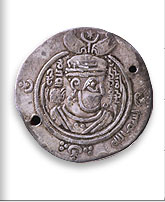
 |
|
|
|
|
|
|
|
|
|
|
|
|
|
| Home > Biographies > Charlemagne |
 |
Charlemagne
In the year 788 CE Roland, Warden of the Breton Marches, was killed during Charlemagne’s first campaign in Muslim Spain. In the east the Arabs and the Bulgarians defeated the Byzantine army Abbasid power remained at its height during the rule of Harun ar-Rashid, who was caliph in Baghdad. From 786 to 809 CE Charlemagne and Harun maintained contact: Charlemagne was Harun’s counterweight to the Umayyad power in Spain, and Harun helped Charlemagne in his rivalry with the East Roman Empire. These contacts are welldocumented in Christian sources:
“Then he [Charlemagne] came to the Most Holy Sepulchre of our Lord and Savior Jesus Christ [also the place of the Resurrection], adorned the holy place with gold and gems, and also placed on it an immense gold banner. Amongst all the holy places he specially adorned the Manger of the Lord and his Sepulchre, for King Aaron [Harun] granted him permission to do as he wished. And what garments and spices, and wealth of eastern treasures he gave Charles! Then going on, the Most Prudent King went with King Aaron as far as Alexandria, and the Franks and Hagarenes rejoiced together as if they were blood brothers. So Charles said farewell to King Aaron, who returned to his own country.” (Benedict, Monk of St. Andrew on Mt. Soracte, Chron. 23-PL 139,95) Charlemagne succeeded in creating for himself a most powerful position in Western Europe, and therefore it was only natural for Christians that their greatest Emperor would be treated respectfully by other Emperors. These contacts probably meant more to Charlemagne, ambitious to rule the West, than they did to Harun, riding as he was on the crest of the Abbasid wave. This view is supported by the fact that Muslim authors do not report these contacts. Charlemagne’s biography Life was written by Eginhard around 820 CE. According to this source, Charlemagne sent an embassy to the East in 799 CE, taking presents to the Holy Sepulchre. A year later he received a blessing from the patriarch and the keys of the Holy Sepulchre and Calvary, with a banner. Eginhard goes on to say that when these gifts were received by Harun “not only did he grant their requests, but he also conceded that the sacred and saving place [the Holy Sepulchre] should be assigned to his jurisdiction”. Bernard the Monk, who wrote some seventy years thereafter, supports this tale by saying that he stayed in the hospice of Charlemagne. |